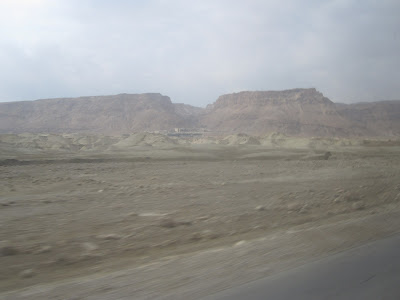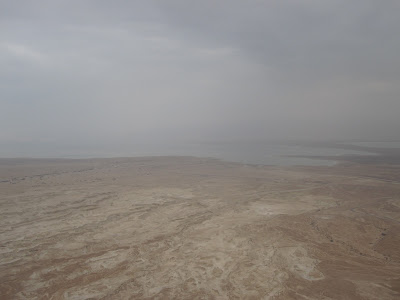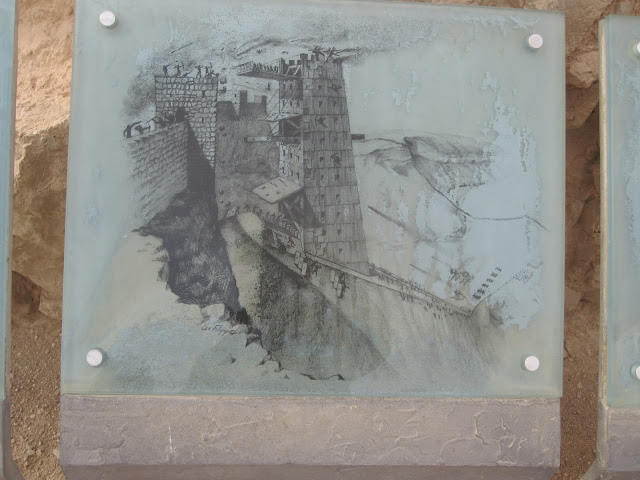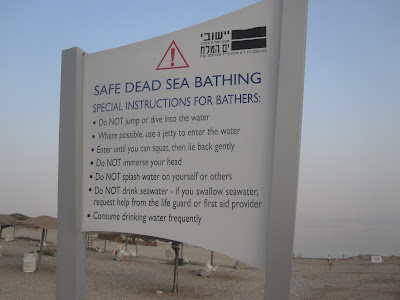23 December 2012
Departed Frankfurt at 1140 en route to Istanbul, Turkey where we would change planes and then on to Tel Aviv. The day in Germany was dreary and rainy so we didn't mind leaving that behind. Here's our Turkish Airlines plane getting loaded up.
Changed planes in Istanbul, Turkey and since we had a couple hours to kill what better way than with the local favorite, Efes.
Arrived right on time, 2010 (810P) at Ben Gurion Airport outside of Tel Aviv, Israel. Passport control was frustrating. We had an Avis rental car reserved. When we asked for a GPS we were told that Avis hires a third party to supply those and that the guy would meet us at the car. Well, that didn't happen, he never showed up, so we headed out onto the Israeli roads with map only.
Well, the drive to our hotel wasn't too bad, just missed one exit and Jeff's navigation skills recovered from that quite nicely. It was close to 2200 (10P) by the time we checked into the hotel and put our bags in the room. So, after a long day it was nice to relax in the hotel lounge.
24 December 2012
Tel Aviv
First full day in Israel. We have no scheduled events. Just planning on a walk about of Tel Aviv. Here's the view out of our hotel room looking east toward the Mediterranean Sea.
We're out on the Tel Aviv promenade just across the street from our hotel, and there's where we're staying, the Sheraton Tel Aviv. Very nice. But, don't plan on bacon or ham with breakfast. In fact, don't plan on meat of any kind for breakfast, lunch or dinner.
Right next door to the Sheraton is the French Embassy. Quite a fortress.
The promenade runs along the Mediterranean shore and seems to go on forever in both directions. A great place for a walk or run.
A quirky Tel Aviv building.
The new Tel Aviv opera house. Very modern. Strange statues look like two naked guys that jumped out of an airplane with their luggage.
Maybe the ugliest building in the world.
Lots of bars along the promenade in Tel Aviv.
Oh, guess I was wrong. This might be the ugliest building in the world.
Stop signs in Israel don't say stop.
Regardless of what your opinions might be of Israel, who have to admit, based on this, that they are a tolerate people. Here's a Muslim mosque smack dab in the middle of Tel Aviv. The Israeli population is about 20% Arab and most of those are Muslims. I'm guessing there probably aren't any synagogues in Damascus or Tehran or Baghdad. A large percentage of the Muslim world wants to destroy the Israeli nation but they're still allowed to worship within their country.
We stopped for lunch at Mike's Place. This bar/restaurant was blown up by a suicide bomber in 2003.
Fish and chips at Mike's. Take note, ketchup in Hebrew.
Now we're at 16 Rothschild Boulevard in Tel Aviv, Independence Hall. This is where Israel's first Prime Minister, David Ben-Gurion read the country's Declaration of Independence on 14 May 1948. Not quite as nice as our Independence Hall in Philadelphia.
Across the street from Independence Hall is this statue of Meir Dizengoff, the first mayor of Tel Aviv. Tel Aviv was founded in 1909 on the outskirts of the ancient port town of Jaffa. Jewish immigration resulted in the city quickly outgrowing Jaffa and today Tel Aviv is the second most populace city in Israel behind Jerusalem.
The Common Market in Tel Aviv. Seemed like most of the folks shopping in the market were Arab women.
Sunsets go especially well with a bit of the amber nectar; Goldstar, a local Israeli beer.
Walking back to the hotel at the end of the night we saw this sign. Who knew that Hebrew was such an easy language to learn.
Christmas, 25 December 2012
Masada
26 December 2012
Nazareth
Sea of Galilee
Masada
We're on an all day tour to Masada and the Dead Sea. From Tel Aviv we drove through the north side of Jerusalem and then began our descent into the low lands east of the city. It really is an amazing transformation. West of Jerusalem the terrain is green and plush but very quickly after leaving the city to the east it becomes a barren desert. From here on, the drive descends below sea level until we get to the lowest point on terra ferma, the Dead Sea.
There's so much history in this part of the world and, of course, these tours can't stop at every point of significance. For example, along the way to Masada and the Dead Sea, off there on the horizon is the ancient city of Jericho.
Here's another one of those points of interest and significance that we didn't have time to see. In this valley, known as Wadi Qumram, is where Bedouin tribesmen found the Dead Sea Scrolls in a series of twelve caves beginning in 1946.
And here's one of our early pictures of the Dead Sea. The Dead Sea is the lowest point on land any where in the world at 423 meters, 1237 feet below sea level. The waters of the Dead Sea have greatly receded in the last 150 years. British surveys then showed that the road that we're driving on would have been under water 150 years ago.
At the southwestern tip of the Dead Sea is Masada. Masada was a fortress and palace built on a rock plateau by Herod the Great around 35 BCE. During a Jewish revolt against Rome in 66 AD, 960 zealot Jewish rebels, along with their families, retreated onto Masada. In 73 AD 15,000 Roman soldiers laid siege to Masada to finally crush the Jewish rebellion.
Masada is the plateau on the right. The three tiered palace on the norther tip of the plateau can be seen on the far right end of the plateau.
This facility is at the base of the plateau and houses a movie theater, small museum, food court and, most importantly, the cable car station that takes us to the top of Masada.
Of course, back in 66 AD the only access to Masada was via a steep foot path. Now, a three minute cable car gets us to the top, 1300 feet above the desert floor.
We're on the Masada plateau now. Here's the Dead Sea from the top.
Looking back to the south across Masada and the Dead Sea beyond.
Masada was a large fortress with walled fortification running along the entire rim of the plateau.
After the Roman siege of Masada it was used briefly during early Byzantine times but after that it remained untouched for over 1500 years when it was found again in 1842. Serious excavation didn't occur though until 1963. Some renovation has been done so that people can better visualize what buildings looks like then. Any such structures have a black line that shows anything below that line is original, anything above a renovated section.
Inside many of the Masada buildings are examples of decorative frescoes. Amazingly, much of the colors are still bright and vibrant 2000 years later.
Jeff and I on Masada with the Dead Sea behind.
Looking north on Masada across storage rooms, the bath house to the left and the northern palace remains.
This was an olive oil storage room. The circular holes in the floor were to collect any oil that might leak from containers which could then be easily scooped out and put into a new container.
A model of the three tiered north palace on Masada. We're standing at the top level.
Looking over the edge of the plateau down to the second level of the palace.
From the northern palace looking south across the storage rooms and the Dead Sea beyond.
Mosaic tiled floors in the Masada bath house.
The bath house floor on Masada. Hot air would be pumped into the pillared area below the bath house floor which would heat the water.
Two millennium decorative tiles on the Masada bath house.
This building housed pigeons that could be used for sending and receiving messages.
Now here's what makes the Masada story so intriguing. Once the 15,000 Roman soldiers arrived at the base of the plateau they realized they would not be able to conquer the 960 Jews 1300 feet above them by using the narrow footpaths. So the Romans built an earthen ramp up to the walls of Masada on which they then moved a huge siege tower and battering ram to the top. This is what remains of that ramp.
Here's an artists depiction of the ramp and siege tower. After a couple months the Romans were able to breach the Masada defenses but then retreated for the night to their camps below. The Jews of Masada knew that they faced certain slavery or worse and so, on that last night, all 960 Jews were killed by ten chosen men of their group. Finally, those last ten men drew lots to decide on who would kill the remaining nine and then commit suicide. The following morning the Romans found all the Jews dead and all building set ablaze except for the storage rooms. The full storage rooms remained to show the Romans that the Jews had not been defeated because of depleted supplies.
Back in the van on our way to some swimming in the Dead Sea. The waters of the Dead Sea, which are 36% salt, are ten times saltier than the oceans of the world which contain about 3.5% salt. Because of that Dead Sea waters are very buoyant.
Some warnings before getting into the Dead Sea waters.
One more meter to the shore line, -423 meters below sea level. Jeff had to swim alone since I forgot my bathing suit.
Almost like being on a float. You can actually float in a foot of water in the Dead Sea.
The bottom of the Dead Sea, at least in this area, has this black mud that is said to have amazing skin recuperative powers. In fact, there's a whole industry that sells Dead Sea products for the skin. So putting black mud on yourself and others is something for folks to do that aren't happy with just floating.
Jeff didn't get into the mud but after all that floating a Goldstar was certainly in order.
Here, on the shore of the Dead Sea, is the only Christmas Tree we saw on this Christmas day of 2012. From here we made the nearly two hour drive back to Tel Aviv.
26 December 2012
Nazareth
Next morning we're on our way to northern Israel to Nazareth and the Sea of Galilee. Along the way we passed this rather wealthy Arab town with near palatial homes. Jeff said the architecture was very similar to what he'd seen in Kuwait City.
Another mosque in Israel. Probably aren't any synagogues in Gaza or Syria or Egypt or any other Arab country where it just wouldn't be tolerated.
Almost to Nazareth. Nazareth was the childhood home of Jesus. Today the town is 70% Muslim, 30% Christian.
A shop in Nazareth selling Christmas decorations.
Our tour guide took us to the Nazareth "Art Center." It's really a souvenir store selling the standard stuff. I think our guide gets a cut.
Church of the Annunciation is one of our destinations in Nazareth. The Church of the Annunciation was built over the site where the angel Gabriel revealed himself to Mary and told her that she would become pregnant with the Son of God.
A Muslim jab at Christian pilgrims on the way to the Church of the Annunciation.
The entrance to the lower lever of the Church of Annunciation. This church was built in 1969 where a previous Crusader-era church had stood and, prior to that, a Byzantine church.
In front of the Church of the Annunciation.
Two large metal doors at the entrance to the church. This one depicts scenes from the Old Testament.
This door shows the New Testament scenes of the life of Jesus.
Inside the Church of the Annunciation. In the center and below is the grotto that was of the home of Mary.
The grotto in the Church of the Annunciation, the home of Mary and where Gabriel revealed himself.
Inside the grotto.
On the second level of the Church of the Annunciation countries from all over the world have sent art works for display here in the church. This is from Japan, a mosaic of Mother and Child. Mary's blouse is made of hundreds of pearls.
A video of the service in the chapel of the Church of the Annunciation. Interesting dynamics here. The service is in Arabic. While we were there a little Jewish man walked in and sat down so not sure what that was about. Pretty chapel.
Nazareth today.
Nazareth today.
Excavated Nazareth which reveals the streets and buildings of Nazareth 2000 years ago, the time of Jesus' childhood.
The Church of the Annunciation from the Church of St. Joseph.
The Church of St. Joseph was built over the site of Joseph's carpenter workshop.
Beneath the Church of St. Joseph are ancient ruins. Among those ruins is this Mikveh, a Jewish ritual cleansing bath.
OK, done in Nazareth, we're on our way to the Sea of Galilee
Outside of Nazareth, on the way to the Sea of Galillee, we could see Mount Tabor, behind the tree, where the Transfiguration of Jesus occurred, achieving divine radiance, and where he spoke with Moses and Elijah.
A beautiful valley in Galilee.
Sea of Galilee
Jeff at the Sea of Galilee. The Sea of Galilee is the lowest fresh water lake in the world and second lowest lake after the Dead Sea. Jesus spent some three years of his life living along the Sea of Galilee.
Here is the Church of the Primacy of St. Peter built on the shore of the Sea of Galilee.
Inside of the Church of the Primacy of St. Peter is this rock called the Mensa Christi, Latin for Table of Christ. This is where Jesus presented a breakfast of fish and bread to his disciples after the miracle catch of fish and where Jesus told Peter to "Feed my sheep."
Jeff and I on the shores of the Sea of Galilee. There is so much Biblical significance here. The Sermon on the Mount, Jesus calmed to the storm and walked on water. Here he fed the 5000 with just a few fish and a basket of bread.
Back in the van. Again there's so many sites and places that we didn't have time to stop. We had passed through the town of Cana, now Kafr Kanna, which is where Jesus performed his first miracle of turning water into wine and also near the ancient town of Magdala believed to be the home town of Mary Magdalene. Here's another of the places we passed by, Mount of Beatitudes, where Jesus gave the Sermon on the Mount.
I'm standing in front of the ruins of two churches that were built around the ruins of the home of St. Peter in the village of Capharnaum.
There a Biblical verses that tell of Jesus and Peter attending synagogue in Capharnaum then walking to the home of Peter. These are the ruins of the synagogue in Capharnaum just a short walk from the ruins of Peter's home.
A closer image of the ruins of the synagogue of Capharnaum. The lower, black volcanic rocks are from the original synagogue of Jesus' time. The newer, white synagogue was built on top of the original foundation.
Fisherman still work on the waters of the Sea of Galilee.
A statue of St. Peter at Capharnaum.
It's time for lunch and since the Jesus Restaurant was full we ate at the St. Peter's Restaurant.
Well, since we were on the Sea of Galilee Jeff and I both tried the local catch, Tilapia zilli (redbelly tilapia) "St. Peter's fish."
Strange rodents running around the rocks on the shore of the Sea of Galilee. Our guide didn't know the English name but said the Hebrew name translated to Rock Rabbit. Now that we're home we've learned they're called a Hyrax.
Last stop of the day was at the southern tip of the Sea of Galilee where the lake flows into the Jordan River. This place is quite misleading. It would give you the impression that this is where Jesus was baptized in the Jordan but that actually happened well south of here near Jericho. But, it's still water fresh from the Sea of Galilee and it is the Jordan River.
You think they cater to the Christian community here?
They have a operation here that enables you to enter the river and renew your baptism. They sell you the big white shirt and have dressing rooms for you to get ready.
As I mentioned, it is the Jordan River and just feet from it's source, the Sea of Galilee, so we got a small bottle of water.
Looking south down the Jordan River.
We're on our way back to Tel Aviv and as we drive away we can see across the Sea of Galilee to the Golan Heights. Prior to the 1967 Six-Day War the Golan Heights were owned by Syria who stationed artillery batteries there and would shoot onto the Israeli villages on the east side of the Sea of Galilee. In addition to simply kicking ass on Egypt, Syria and Jordon, Israel confiscated land from each of the three Arab countries including these Golan Heights.
We had a long drive back to Tel Aviv, two hours through the crazy Israeli traffic. Once there we got in our rental, with no GPS, and drove to Jerusalem and to our hotel for the next three nights. Our Jerusalem adventures in the next blog. Shalom!!

































































































Glad you guys got to Tel Aviv safely...especially with just maps. It reminds me of our road trips when I was little and Daddy always had the map out. The drinks and goodies in the lobby look yummy.
ReplyDeleteWow...the Mediterranean Sea is beautiful!! Lots of ugly buildings in Israel. VERY interesting about the mosque in the middle of Tel Aviv...very tolerant.
Wow, all the pictures of the Dead Sea are amazing! Seeing the model of Masada is pretty cool to get an overall idea of how it looks. The story of the Jews killing themselves so that they would not be enslaved by the Romans is very interesting. I love the pictures of Daddy floating in the Dead Sea.
The town of Nazareth is 70% Muslim?!? That's crazy! The Church of Annunciation is amazing. It's cool seeing Mary's home and all the details about Gabriel coming to see her. All of the pictures of the Sea of Galilee are amazing. I love learning about all of the history and significance surrounding Jesus. That's funny that you ate at St. Peter's Restaurant. I didn't know that Tilapia is called St. Peter's fish. The Hyrax is so cute! That's cool that you got a bottle of water from the Jordan River.
Great blog!
Wonderful description
ReplyDelete